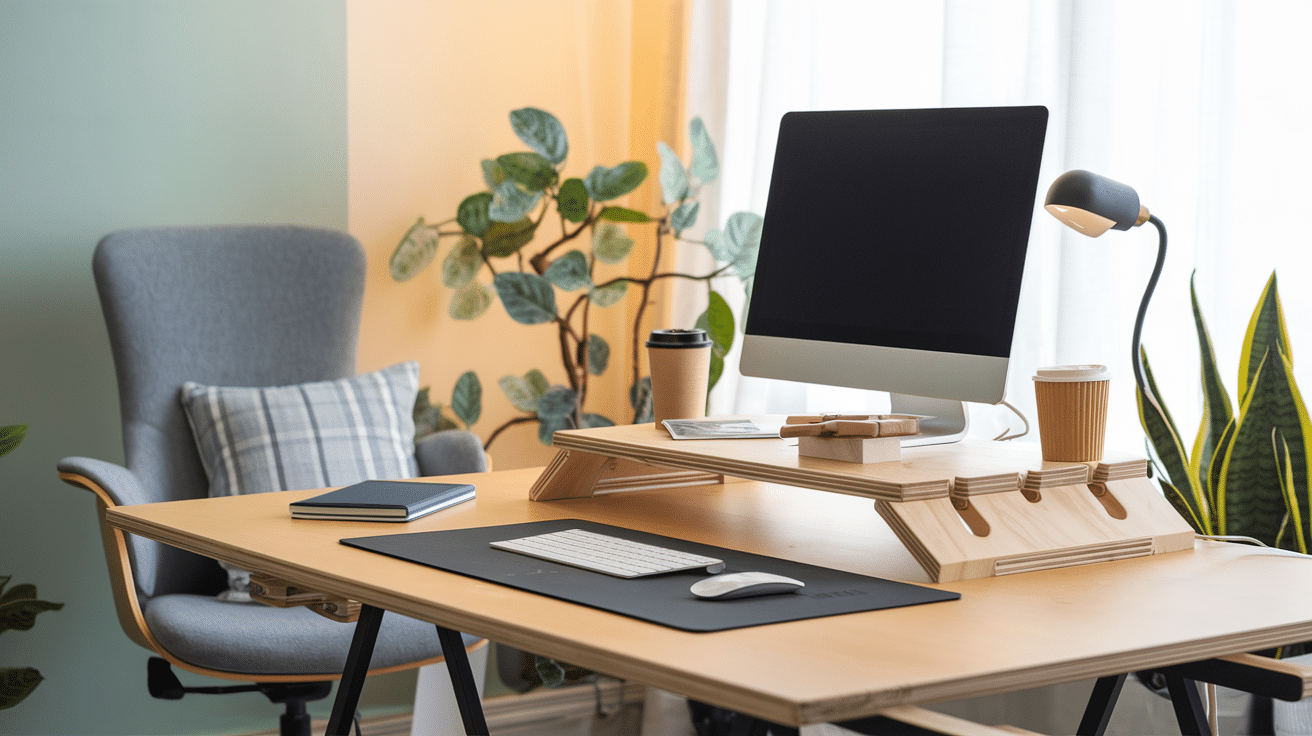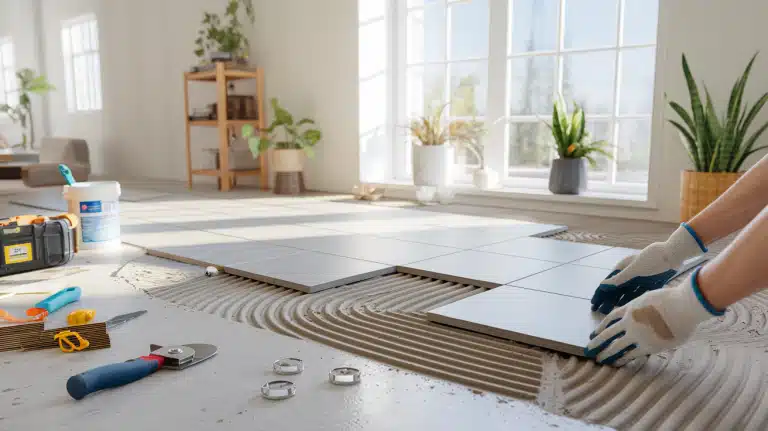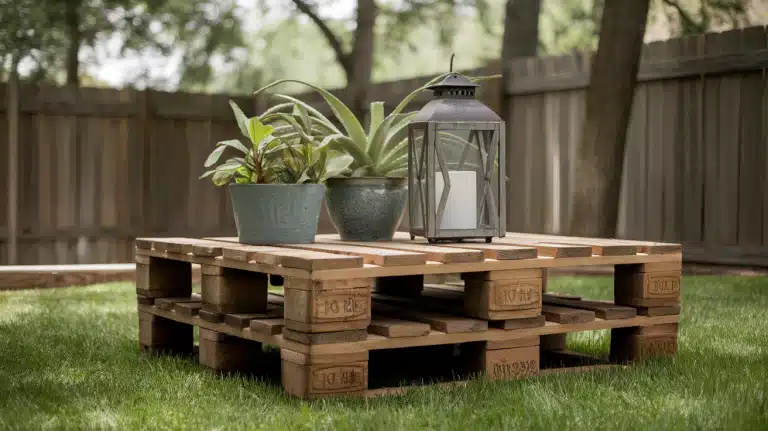DIY Computer Desk in 6 Easy Steps
Building a computer desk can cost a fortune these days. I know the feeling – I spent hours searching for one that looked good and fit my budget.
After seeing prices ranging from $1,000 to $3,000 for quality hardwood desks, I decided to make my own.
Here’s the good news: You can build a beautiful hardwood desk for under $500.
The design I’m sharing looks like solid wood through and through but uses smart construction methods to keep costs low.
I’ll show you six simple steps to build a solid computer desk in this guide. You’ll learn exactly how to select materials, construct the top, build the legs, and put it all together.
DIY Studio Desk Construction Guide
Tools Required
| Tool | Purpose |
|---|---|
| Table Saw or Circular Saw | Cutting wood to size |
| Miter Saw | Angle cuts |
| Drill | Making holes, driving screws |
| Brad Nailer | Securing thin pieces |
| Orbital Sander | Finishing surfaces |
| Router (optional) | Edgework |
| F-Clamps | Securing pieces while working |
| Pipe Clamps | Large surface clamping |
| Speed Square/Rafter Square | Guide for straight cuts |
| Measuring Tape | Measurements |
| Forstner Bit | Counter-sinking screws |
| Hole Saw | Cable management holes |
Materials list
| Material | Quantity | Notes |
|---|---|---|
| Treated Pine (90x45mm) | ~18m | For leg structure |
| Plywood (32mm) | 2.4m x 600mm | For tabletop |
| Hardwood Lining Boards (14mm) | As needed | For cladding |
| Timber Battens (Jarrah/Spotted Gum) | For edging | |
| Timber Bond Type II Glue | 1 bottle | For all wood joints |
| 30mm Brad Nails | 1 box | For securing cladding |
| 75mm Square Head Screws | 1 box | For leg assembly |
| Black Wafer Head Screws | 1 box | For edging |
| Wood Filler | 1 container | Matching timber color |
| Hard Wax Oil | 500ml | For Finishing |
DIY Computer Desk: Step-By-Step Construction
Step 1: Creating the Tabletop
Let’s start with the heart of your desk – the tabletop. I used a 32mm plywood board as the base, topped with hardwood lining boards. This gives you the look of solid wood without the hefty price tag.
Start by laying out your lining boards to ensure even spacing. Once you’re happy with the layout, apply glue and secure them with brad nails. Let this dry overnight – trust me, rushing this step isn’t worth it.
After it’s dry, add the edging with nice 45-degree corners for a clean look.
Step 2: Preparing the Legs
The legs might look complex, but they’re pretty straightforward. Cut your treated pine pieces at 10-degree angles – this gives the desk a slight tilt that looks great.
You’ll need the bottom pieces at 425mm, the top at 160mm, and the side at 800mm.
If you want to hide your cables (which I highly recommend), then create that channel in one leg. Think about which side you want your cables to run down.
Step 3: Cladding the Legs
Here’s where the magic happens – making those simple pine legs look like solid hardwood. Cut strips of your hardwood lining boards to size and attach them with glue and brad nails. Take your time with this step.
Make a removable back panel for your cable management leg – these little details make the desk special. Once everything’s attached, give it all a good sanding.
Step 4: Bringing It All Together
This is the moment of truth – attaching the legs to your tabletop. Position your legs carefully – I like measuring equal distances from the edges to ensure everything’s centered.
Mark your positions using a speed square to keep things straight. If you’re doing cable management, drill those holes now. Then secure everything with screws from underneath.
Take your time with this step – a wobbly desk is no fun.
Step 5: Adding Your Personal Touch
Now’s when you can make the desk your own. Want a keyboard drawer? Add it now. Need a cable management system? This is the time to set it up.
I added a keyboard drawer using soft-close slides rated for 45kg – it’s smooth as butter and strong enough to hold plenty of gear. The key here is thinking about how you’ll use the desk and adding features that make your life easier.
Step 6: The Final Finish
The finishing touches make all the difference. Fill any nail holes with wood filler that matches your timber. Sand everything thoroughly – start with 120 grit and work your way up to 220 for a super smooth finish.
I used hard wax oil to finish – two coats do the trick. It protects the wood while keeping its natural look. Let each coat dry completely before moving or using the desk.
Pro Tip: Keep checking your measurements as you go. As my old woodworking teacher said, “measure twice, cut once” saves you from headaches later. And don’t rush the drying times – good things come to those who wait!
Still unsure? Reference the video by Home on the Tools for a detailed walkthrough of this step.
Essential Tips
- Pre-drill all holes in hardwood to prevent splitting
- Use clamps generously during glue-ups
- Choose drill bits where the thread is visible past the bit for proper pre-drilling
- Keep dust collection off initially when sanding to fill small gaps
- Leave small gaps at the top and bottom of cable management for wire access
- Measure twice, cut once – especially for angled cuts
- Allow proper drying time between gluing and the next steps
- Test fit all pieces before final assembly
Optional Add-Ons For Your Computer Desk
You can enhance your desk’s functionality with several additions. Add extra holes in the tabletop, wire clips underneath, and power strip mounts for cable management.
A cable sleeve or wrap can keep everything tidy. A monitor stand built from matching materials adds height while maintaining the desk’s style. Include a cable pass-through in the stand for clean wire routing.
Storage can be expanded with extra drawers or side shelving. You might add equipment racks or create hidden spots for valuables.
Lighting makes a big difference – try LED strips under the desk or a focused task light for work. Some users add backlighting for a softer effect.
Small touches can improve daily use. A USB hub built into the desk surface saves space. Consider adding power outlets for easy access.
Simple additions like headphone hooks or cup holders keep items off the work surface. These features work best when planned before construction, allowing for clean installation and proper cable routing.
Conclusion
Building a solid computer desk doesn’t need to break the bank.
With about $500 worth of materials and basic tools, you can create a desk that looks like it came from a high-end store.
The shared method combines smart material choices with simple building steps anyone can follow.
Want to start your desk project? Prepare your tools, pick up the materials, and set aside a weekend.
Take time with each step, especially the measurements and drying times.
Your effort will pay off with a desk that fits your space perfectly and saves you money.







